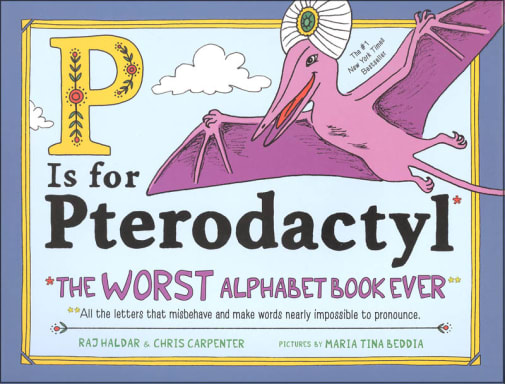While younger ones may appreciate the humorous illustrations and whimsical text, this unique alphabet will engage a reader more. Focusing on troublesome words that defy the rules of the English language, this colorfully illustrated picture book will provide giggles and maybe a bit of eye rolling as children read clever ditties like “B is for Bdellium. We doubt anyone knows what bdellium is, but it's the only word dumb enough to begin with a silent B." Please note, there are references to the Ouija board, witches and psychics. The back of the book includes a glossary with a pronunciation guide that provides definitions for each word in the book. ~Deanne
P Is for Pterodactyl: Worst Alphabet Book Ever
SKU
075923
ISBN
9781492674313
Grade 3-7
Neutral
Non-Consumable
These icons are designed to help you quickly understand and learn important information about our products.
Teaching Method
Traditional
Teacher-centered curriculum commonly used in classrooms that may include a text, teacher manual, tests, etc.
Charlotte Mason
A methodology based on the work of a 19th century educator who maintained that children learn best from literature (Living Books), not textbooks.
Classical
A methodology based on the Latin Trivium (three stages of learning), including the grammar stage (memorization and facts), logic stage (critical thinking), and rhetoric stage (developing/defending ideas).
Unit Study
A thematic or topical approach centered around one topic that integrates multiple subject areas.
Montessori (Discovery)
A methodology based on the work of a 20th century educator that emphasizes student and sensory-driven discovery learning and real-life applications.
Other
Other methodologies
Religious Content
Secular
Contains content contrary to common Christian beliefs (i.e. evolution).
Neutral
Avoids religious or theoretical topics or presents multiple viewpoints without preference.
Christian/Religious
Faith-based or including instructional religious content.
Learning Modality
Auditory
Learns through listening, talking out loud or reading out loud.
Visual
Learns through seeing, prefers written instructions and visual materials.
Kinesthetic/Tactile (Hands-On)
Learns through moving, doing and touching.
Multi-Sensory
Curriculum that employ a variety of activities/components.
Presentation
Sequential
Curriculum progresses through well-defined learning objectives. Emphasizes mastery before moving to the next topic.
Spiral
Topics and concepts are repeated from level to level, adding more depth at each pass and connecting with review.
Conceptual/Topical
Focus is on the “why,” often with a unifying concept as well as specific skills; coverage may be broader.
Teacher Involvement
Low Teacher Involvement
Student-led materials; parent acts as a facilitator.
Medium Teacher Involvement
A mix of teacher-led time and independent student work.
High Teacher Involvement
Teacher-led lessons; may utilize discussions, hands-on activities and working together.
Additional Materials Required
No other materials needed
Everything you need is included.
Other Materials Required
There are additional required resources that are a separate purchase.
Other Materials Optional
There are additional resources mentioned or recommended but are not absolutely necessary.
Consumable
Consumable
Designed to be written in; not reusable.
Non-Consumable
Not designed to be written in; reusable.
Our Price
$17.99 $17.99 $13.95
Rainbow Savings: $4.04
Description
Publisher's Description of P Is for Pterodactyl: Worst Alphabet Book Ever
Let's get real—the English language is bizarre. A might be for apple, but it's also for aisle and aeons. Why does the word "gnat" start with a G but the word "knot" doesn't start with an N? It doesn't always make sense, but don't let these rule-breaking silent letters defeat you! This whimsical, funky book from Raj Haldar (aka rapper Lushlife) turns the traditional idea of an alphabet book on its head, poking fun at the most mischievous words in the English language and demonstrating how to pronounce them. Fun and informative for word nerds of all ages!
Details
| Product Format: | Hardcover |
|---|---|
| Grades: | 3-7 |
| Brand: | Sourcebooks Explore |
| ISBN: | 9781492674313 |
| Length in Inches: | 8.75 |
| Width in Inches: | 11.375 |
| Height in Inches: | 0.5 |
| Weight in Pounds: | 1 |
Videos
Reviews

